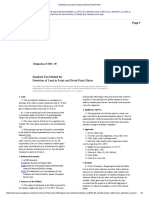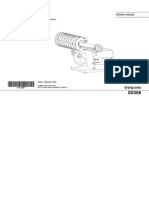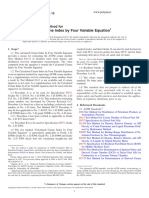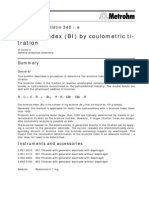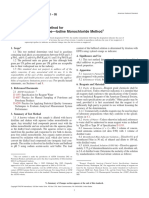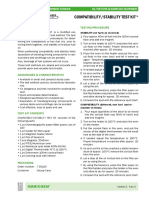Bromine Index Determination
Bromine Index Determination
Uploaded by
Abhik BanerjeeCopyright:
Available Formats
Bromine Index Determination
Bromine Index Determination
Uploaded by
Abhik BanerjeeOriginal Description:
Copyright
Available Formats
Share this document
Did you find this document useful?
Is this content inappropriate?
Copyright:
Available Formats
Bromine Index Determination
Bromine Index Determination
Uploaded by
Abhik BanerjeeCopyright:
Available Formats
Applications
Bromine number and bromine index
of petroleum products
Petroleum products normally consist of a mixture of many different hydrocarbon molecules
containing C=C double bonds. The number of double bonds corresponds to the degree of
unsaturation. This is an important quality parameter for many raw materials and finished
products such as hydrocarbon fuels and lubricants. How is it determined in practice?
T. Fossum
Bromine number and bromine index
are analytical procedures designed to
determine the degree of unsaturation
or content of reactive C=C double bonds
(olefins) in a hydrocarbon. C=C double
bonds can crosslink or react with oxygen
to form epoxides, which are also highly
reactive. The crosslinking causes the
hydrocarbon to form long chain molecules (polymers) which are no longer
liquid but solid and are termed gums or
varnishes. These form deposits in a fuel
system or in a carburetor and can clog
up filters and the narrow tubing that
supplies fuel to the internal combustion
engine. The reduced fuel flow results in
a reduction in engine power and might
even prevent the engine from starting.
The titration uses
a simple reaction
The main reaction in bromine number
titration is the addition of one molecule
of diatomic bromine to the C=C double
bond. One bromine atom adds on each
side, one to each carbon atom (Fig.
1). In the titration, bromine is steadily
metered in while the level of bromine is
detected by a polarized double-pin platinum sensor. When the bromine level is
Figure 1:
Reaction scheme
for the addition
of bromine to the
double bond of
cyclohexene.
low, more bromine is added. When no
more double bonds are present to react,
the level of bromine in the solution rises and the titration is terminated. The
amount of bromine added corresponds to
the amount of olefin originally present.
The bromine number is the quantity of
bromine in grams that reacts with 100
grams of sample under the test conditions. The bromine index is the number
of milligrams of bromine that react with
100 grams of sample.
Other reactions in which bromine can
participate are oxidation, substitution,
and reactions with sulfur, nitrogen or
oxygen-containing compounds. The oxidation and substitution reactions occur
more slowly at low temperatures. For this
reason, the ASTM D1159 (bromine number of petroleum distillates and olefins),
ASTM D2710 (bromine index of hydrocarbons) and ASTM D5776 (bromine
index of aromatic hydrocarbons by electrometric titration) standard test methods are all specified to be conducted at
temperatures of 0 to 5 C. In alpha-olefins, the double bond is between the end
carbon and the adjacent carbon. These
compounds do not react so readily with
bromine and the reaction is incomplete.
UserCom 14
The Excellence titrators are ideal for determining bromine number and bromine
index. The One Click shortcut for bromine number makes it easy to start the
analysis. The Solvent Manager activates
solvent exchange with One Click and so
protects the user from contact with the
chemicals. The thermostatable beaker
keeps the solution between 0 and 5 C.
An external refrigerated circulating ther-
Br
Br+
Br
METTLERTOLEDO
The conditions for the potentiometric
(electrometric) determination of the bromine number or bromine index include
an acidic polar solvent consisting of glacial acetic acid (714 mL), trichloroethane
or dichloromethane (134 mL), methanol (134 mL) and sulfuric acid (16.7%,
18 mL). The mixture is held at 0 to 5 C
while a bromide-bromate titrant (KBrO3
and KBr) is added in small increments.
The titration is monitored by a double
platinum pin electrode charged positively
on one pin and negatively on the other by
a constant current. The endpoint is reached when a significant change in potential occurs. A preset endpoint is defined
in this region. The titration is terminated
when the potential remains the same at
this endpoint.
Br2
Br
12
Bromine number made easy
Br
Br
mostat is needed for this low-temperature
analysis. This applies to the bromine index as well. The method is changed to an
EQP (equivalence point) titration for low
bromine index levels.
Bromine index
clean and elegant
An especially clean, elegant and accurate
way to determine the bromine index is to
use coulometric titration. The bromine
is generated directly in the titration vessel by a current supplied by a platinumbased electrolysis cell instead of through
addition from a burette. Fewer chemicals
need to be handled and the current generates bromine more accurately than it
can be dispensed using a typical burette.
The ASTM D1492 standard describes a
test method for the coulometric determination of the bromine index at low concentrations. This is performed at room
temperature using a fritless electrolysis
cell. Typical samples from industry have
bromine indices in the range of 2 to 50
for clean aromatic samples such as benzene, toluene, or xylene. The bromine
index of raffinates, which are cracked
hydrocarbons destined for gasoline production, can be much higher of the order
several hundred to several thousand.
The METTLER TOLEDO C30X coulometer
is a powerful instrument that can be used
to determine the water content of a variety of samples according to Karl Fischer.
It also offers a special method for the fast
and accurate determination of the bro-
mine index. The control is fast for high
values of the bromine index and cautious
for small values. This allows accurate
and reproducible determination of even
low one-digit bromine indices using a
mercury-free solvent. The simple method
enables determinations to be made without having to develop a specific procedure
because predefined method templates
can be used. The solvent is blanked out
and subsequent samples are all analyzed
with the same method.
Figure 2:
T70 titrator for
bromine index
and TAN/TBN
determination.
and with One Click
The One Click user interface offers direct
access to all routine tasks. One click
is all it needs to start a method, run a
sample or change the solvent. The ingenious design of the coulometric currentelectrolysis cell makes cleaning easy and
offers high accuracy. The titration vessel
is emptied and refilled by activating the
Solvent Manager from the titrator. This
avoids contact with chemicals. Using
the C30 coulometer, you can be sure that
your samples meet the technical specifications.
Theoretical
value
Result
srel
[%]
141
144,2
0,9
8,5
10,1
0,3
3,8
6,0
1,3
0,9
1,9
0,2
Hexan
1,4
0,3
Table 1:
Results obtained
using the C30 coulometer. Samples
were cyclohexene
diluted with toluene.
Figure 3:
The C30X
coulometer in
routine use.
METTLERTOLEDO
UserCom 14
13
You might also like
- Cambridge Lower Secondary Science Stage 8 End of Unit Test Answer KeyDocument9 pagesCambridge Lower Secondary Science Stage 8 End of Unit Test Answer Keyteamalpaca33No ratings yet
- Astm D1655 22Document11 pagesAstm D1655 22JoaoNo ratings yet
- ASTM E3116 ViscosidadDocument5 pagesASTM E3116 ViscosidadOscar ValenciaNo ratings yet
- POGIL KeyDocument2 pagesPOGIL Keyfiue100% (1)
- Uop 778-81 PDFDocument3 pagesUop 778-81 PDFhadiranjiNo ratings yet
- D3618-05 Detection of Lead in Paint and Dried Paint Films1Document3 pagesD3618-05 Detection of Lead in Paint and Dried Paint Films1Sara SánNo ratings yet
- Astm D 5341 - 99 (2010) PDFDocument4 pagesAstm D 5341 - 99 (2010) PDFServando LozanoNo ratings yet
- Question and Answer of Optical FibreDocument15 pagesQuestion and Answer of Optical FibreSai Printers67% (3)
- Delayed COker in Hysys 1Document201 pagesDelayed COker in Hysys 1nbsmaniannNo ratings yet
- Excel Unit Op TutorialDocument11 pagesExcel Unit Op TutorialEleazar RodriguezNo ratings yet
- Uop304 08Document13 pagesUop304 08Muhannad NasifNo ratings yet
- ASTM D1159 - Standard Test Method For BRDocument10 pagesASTM D1159 - Standard Test Method For BRVishal GoswamiNo ratings yet
- IP 30 - Detection of Mercaptans, Hydrogen Sulfide, Elemental Sulfur and Peroxides - Doctor Test Method - EI - Publishing PDFDocument2 pagesIP 30 - Detection of Mercaptans, Hydrogen Sulfide, Elemental Sulfur and Peroxides - Doctor Test Method - EI - Publishing PDFSanzeeda Baig ShuchiNo ratings yet
- Proximate Analysis of Coal and Coke by Macro Thermogravimetric AnalysisDocument13 pagesProximate Analysis of Coal and Coke by Macro Thermogravimetric AnalysisNoor MuhammadNo ratings yet
- Determination of Total Oxygen in Gasoline and Methanol Fuels by Reductive PyrolysisDocument5 pagesDetermination of Total Oxygen in Gasoline and Methanol Fuels by Reductive Pyrolysisjawed iqbalNo ratings yet
- First Edition 1st Rev Aug 08 Handbook Environmental ScienceDocument72 pagesFirst Edition 1st Rev Aug 08 Handbook Environmental ScienceAshwin MNo ratings yet
- Determination of The Total Acid NumberDocument9 pagesDetermination of The Total Acid NumberAbu WildanNo ratings yet
- Cuptor DO308Document38 pagesCuptor DO308Dumitru Marius0% (1)
- Conradson Carbon Residue of Petroleum Products: Standard Test Method ForDocument7 pagesConradson Carbon Residue of Petroleum Products: Standard Test Method ForNelson Jara CobosNo ratings yet
- Presentation: Nma/MmtDocument20 pagesPresentation: Nma/MmtMalik Zaryab babarNo ratings yet
- Salinómetro PETROTESTDocument2 pagesSalinómetro PETROTESTGambeatNo ratings yet
- ASTM Volume 15.04, September 2019 Soaps and Other Detergents Polishes Leather Resilient Floor CoveringsDocument7 pagesASTM Volume 15.04, September 2019 Soaps and Other Detergents Polishes Leather Resilient Floor CoveringsRao Fahim Nazar100% (1)
- Review About MonoethanolamineDocument59 pagesReview About MonoethanolaminebexigaobrotherNo ratings yet
- Astm D-1266 PDFDocument11 pagesAstm D-1266 PDFDzia RizqiNo ratings yet
- Carbon Black-Oil Absorption Number (OAN) : Standard Test Method ForDocument6 pagesCarbon Black-Oil Absorption Number (OAN) : Standard Test Method ForLevent GüzelNo ratings yet
- ASTM D346 (M) −2011 Collection and Preparation of Coke Samples for Laboratory Analysis 焦炭的采集与准备Document5 pagesASTM D346 (M) −2011 Collection and Preparation of Coke Samples for Laboratory Analysis 焦炭的采集与准备Winnjone YinNo ratings yet
- Calculated Cetane Index by Four Variable Equation: Standard Test Method ForDocument5 pagesCalculated Cetane Index by Four Variable Equation: Standard Test Method ForAnastasia Ayu PratiwiNo ratings yet
- Determination of Aluminum and Silicon in Fuel Oils by Ashing, Fusion, Inductively Coupled Plasma Atomic Emission Spectrometry, and Atomic Absorption SpectrometryDocument6 pagesDetermination of Aluminum and Silicon in Fuel Oils by Ashing, Fusion, Inductively Coupled Plasma Atomic Emission Spectrometry, and Atomic Absorption SpectrometryahmedNo ratings yet
- Crystallinity of PolymerDocument26 pagesCrystallinity of PolymerChetan BholeNo ratings yet
- ASTM D6866 Beta Analytic Andrew PalDocument27 pagesASTM D6866 Beta Analytic Andrew PalBeta AnalyticNo ratings yet
- Astm D409 D409M - 2011 - 208417808126Document14 pagesAstm D409 D409M - 2011 - 208417808126Simin Coke Co.No ratings yet
- Norma Astm C911 PDFDocument4 pagesNorma Astm C911 PDFLEONARD CERDAN100% (1)
- Astm 4377-2011 Karl FischerDocument7 pagesAstm 4377-2011 Karl FischerManuel Peña BenavidesNo ratings yet
- Coal AnalysisDocument3 pagesCoal AnalysisSatish ReddyNo ratings yet
- Water in Crude Oils by Potentiometric Karl Fischer TitrationDocument7 pagesWater in Crude Oils by Potentiometric Karl Fischer TitrationJulian Felipe Noguera CruzNo ratings yet
- Indice de BromoDocument7 pagesIndice de Bromopons5No ratings yet
- Astm D2234 D2234M 16Document2 pagesAstm D2234 D2234M 16SamuelVamsi100% (1)
- Octane Number PDFDocument9 pagesOctane Number PDFLê Ngọc Huyền80% (5)
- Down FileDocument12 pagesDown FileSalma FarooqNo ratings yet
- 3025 51Document8 pages3025 51rambinodNo ratings yet
- IP 565 Water Effect On Particle CountingDocument5 pagesIP 565 Water Effect On Particle CountingJorge Muñiz100% (2)
- Astm D 4628-02 AasDocument6 pagesAstm D 4628-02 AasAntony HoNo ratings yet
- Aniline Point ReportDocument5 pagesAniline Point ReportToppingNo ratings yet
- Carbon 14 Beta Analytic CIWMDocument26 pagesCarbon 14 Beta Analytic CIWMBeta Analytic100% (1)
- ASTM D3302 D3302M - Total MoisDocument8 pagesASTM D3302 D3302M - Total MoisSimin Coke Co.No ratings yet
- 3 Unit ProcessDocument11 pages3 Unit ProcessMANIKANDAN A SNo ratings yet
- SingaporeLabCap 2009Document36 pagesSingaporeLabCap 2009Mubeen RehmanNo ratings yet
- MEG (Monoethylene Glycol)Document3 pagesMEG (Monoethylene Glycol)Lakshman NaikNo ratings yet
- ASTM E1755-01 Ash in BiomassDocument3 pagesASTM E1755-01 Ash in BiomassNora WilsonNo ratings yet
- Cement Analysis by Pressed PowderDocument4 pagesCement Analysis by Pressed PowderAshraf MohamedNo ratings yet
- Astm D 3341Document4 pagesAstm D 3341Manuel GuzmanNo ratings yet
- PolymerViscosity Lab ReportDocument14 pagesPolymerViscosity Lab ReportBrandeice Barrett100% (1)
- Melting Point of Petroleum Wax (Cooling Curve) : Standard Test Method ForDocument5 pagesMelting Point of Petroleum Wax (Cooling Curve) : Standard Test Method ForMuhannad NasifNo ratings yet
- Beta Analytic Presentation at NNFCC Conference - Linking Bio-Based Materials To Renewable Energy ProductionDocument25 pagesBeta Analytic Presentation at NNFCC Conference - Linking Bio-Based Materials To Renewable Energy ProductionBeta AnalyticNo ratings yet
- Standard Test Method For Surface Area of Catalysts and Catalyst CarriersDocument5 pagesStandard Test Method For Surface Area of Catalysts and Catalyst CarriersCristiano Cavalcanti100% (1)
- GATRONOVA Internship ReportDocument34 pagesGATRONOVA Internship ReportAbdulmunaf SheikhNo ratings yet
- Disclosure To Promote The Right To InformationDocument8 pagesDisclosure To Promote The Right To InformationMayur Khalatkar100% (1)
- Neutralization TitrationDocument10 pagesNeutralization TitrationSyalina ABNo ratings yet
- Compatibility Stability Test KitDocument2 pagesCompatibility Stability Test KitAnonymous DklM65UWfmNo ratings yet
- AsflkjshfkljasdbflashdbflkasjDocument4 pagesAsflkjshfkljasdbflashdbflkasjLeader Larry LagamayoNo ratings yet
- D1159Document9 pagesD1159rpajaro75No ratings yet
- Bromination GreenDocument3 pagesBromination GreenAlex BorneNo ratings yet
- Advanced Pharmaceutical analysisFrom EverandAdvanced Pharmaceutical analysisRating: 4.5 out of 5 stars4.5/5 (2)
- The Role of Chromenes in Drug Discovery and DevelopmentFrom EverandThe Role of Chromenes in Drug Discovery and DevelopmentNo ratings yet
- Soft LinersDocument16 pagesSoft Linersashoorocks100% (1)
- 13 - Foam Cement ConsiderationsDocument50 pages13 - Foam Cement ConsiderationsJoan CorsoNo ratings yet
- 1 Prismaflexcrrtintro Seg12007 110326040426 Phpapp02Document38 pages1 Prismaflexcrrtintro Seg12007 110326040426 Phpapp02Sami Maghrebi100% (1)
- Abbas CV With Pic 1Document2 pagesAbbas CV With Pic 1Abi KhanNo ratings yet
- 1º ESO UNIT 5: The Structure of The Earth: Susana Morales BernalDocument49 pages1º ESO UNIT 5: The Structure of The Earth: Susana Morales BernalCobmogLionjrNo ratings yet
- Spray-Applied Rigid PU Foam For Wall-Roof Insulation - 141B BasedDocument3 pagesSpray-Applied Rigid PU Foam For Wall-Roof Insulation - 141B BasedSyed Israr HussainNo ratings yet
- Crystal structure of hexakis (urea-κ O) chromium (III) dichromate bromide monohydrate from synchrotron X-ray dataDocument11 pagesCrystal structure of hexakis (urea-κ O) chromium (III) dichromate bromide monohydrate from synchrotron X-ray dataMiqdadNo ratings yet
- IC Quiz QuestionsDocument2 pagesIC Quiz Questionsrohan NathNo ratings yet
- 'Rubber Material' Discovered That Could Lead To Scratch-Proof Paint For CarDocument2 pages'Rubber Material' Discovered That Could Lead To Scratch-Proof Paint For CarMatejŠarlijaNo ratings yet
- 7-Science NCERT Practice Question PaperDocument5 pages7-Science NCERT Practice Question Paperrathindra nath deNo ratings yet
- Estudio Ce - Novation ZirconioDocument8 pagesEstudio Ce - Novation ZirconioHugo MoralesNo ratings yet
- 500 WordsDocument6 pages500 WordsNestndt ChennaiNo ratings yet
- Ewens-Bassett Notation Inorganic Compounds - KauffmanDocument3 pagesEwens-Bassett Notation Inorganic Compounds - KauffmanJuano Valls FerrerNo ratings yet
- Indicadores de PSM IOGP 2018Document101 pagesIndicadores de PSM IOGP 2018rodrigo bustosNo ratings yet
- Composite MaterialsDocument4 pagesComposite Materialsbharath2bkrNo ratings yet
- NanotechnologyDocument15 pagesNanotechnologySweeya Sankuru100% (2)
- Chang Kok Yung MSC in Civil EngineeringDocument26 pagesChang Kok Yung MSC in Civil EngineeringFareed Ahmed MemonNo ratings yet
- Synthesis and Application of Dipeptides Current Status and PerspectivesDocument10 pagesSynthesis and Application of Dipeptides Current Status and PerspectivesNeculcea AlexandraNo ratings yet
- Regulation of Export of Fresh Pomegranates To The European Union Through Control of Pesticide ResiduesDocument68 pagesRegulation of Export of Fresh Pomegranates To The European Union Through Control of Pesticide ResiduesSaurabh AroraNo ratings yet
- Technical Specifications With SaddlesDocument6 pagesTechnical Specifications With Saddlesmihaidanpan791No ratings yet
- 065 Isopropyl AlcoholDocument7 pages065 Isopropyl Alcoholeng20072007No ratings yet
- 20557e00 Corrosion Risk Assessment MethodologyDocument38 pages20557e00 Corrosion Risk Assessment Methodologyamra_4185% (13)
- PM 500 Application GuideDocument2 pagesPM 500 Application GuideSpartacus HighlanderNo ratings yet
- 820 PDFDocument907 pages820 PDFBabar Khan NiaziNo ratings yet
- Unit 3 RIGID AND FLEXIBLE PAVEMENTSDocument33 pagesUnit 3 RIGID AND FLEXIBLE PAVEMENTSAnonymous SEDun6PWNo ratings yet





